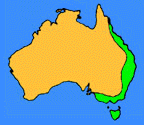
Platypus
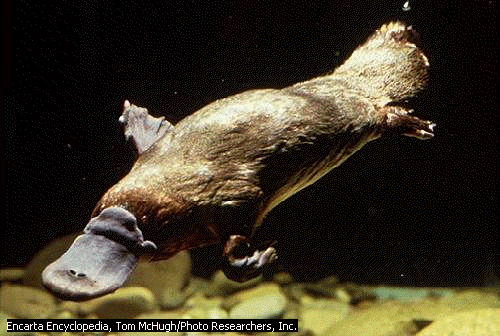 The
duck-billed platypus, found only in eastern Australia, lives in
streams, rivers, and occasionally lakes with year-round water. It
feeds mostly on bottom-dwelling aquatic insect larvae, which it finds
by probing the streambed with its pliable, sensitive bill. It grows
to a maximum size of 2.2 to 5.3 pounds. One of only a few
venomous mammals, the male platypus has a poison gland in the hind
leg that opens through a bony spur on the ankle. The spur is used to
defend against predators and possibly to defend its territory against
other males. The females lack the venom gland and bony spur.
The
duck-billed platypus, found only in eastern Australia, lives in
streams, rivers, and occasionally lakes with year-round water. It
feeds mostly on bottom-dwelling aquatic insect larvae, which it finds
by probing the streambed with its pliable, sensitive bill. It grows
to a maximum size of 2.2 to 5.3 pounds. One of only a few
venomous mammals, the male platypus has a poison gland in the hind
leg that opens through a bony spur on the ankle. The spur is used to
defend against predators and possibly to defend its territory against
other males. The females lack the venom gland and bony spur.
A platypus  (Greek
platys,”broad”; pous,”foot”), or duckbill, is a
semiaquatic, egg-laying mammal native to Tasmania and southern and
eastern Australia. The animal has a bill that resembles a duck bill
but is actually an elongated snout covered with soft, moist, leathery
skin and sensitive nerve endings. The body of the
(Greek
platys,”broad”; pous,”foot”), or duckbill, is a
semiaquatic, egg-laying mammal native to Tasmania and southern and
eastern Australia. The animal has a bill that resembles a duck bill
but is actually an elongated snout covered with soft, moist, leathery
skin and sensitive nerve endings. The body of the 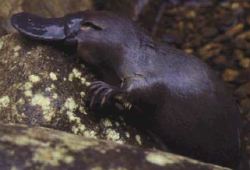 platypus
is 12 to 18 inches long; the flattened tail measures 4 to 6 inches
in length. The feet are webbed. The body and tail are covered with a
thick, soft, woolly layer of fur, from which long, flat hairs
protrude. The most conspicuous feature of the small head is the bill,
which is about 2.5 inches long and 2 inches wide and
platypus
is 12 to 18 inches long; the flattened tail measures 4 to 6 inches
in length. The feet are webbed. The body and tail are covered with a
thick, soft, woolly layer of fur, from which long, flat hairs
protrude. The most conspicuous feature of the small head is the bill,
which is about 2.5 inches long and 2 inches wide and 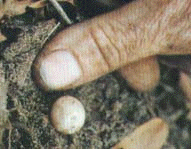
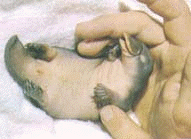 which
the animal uses for detecting prey and stirring up mud at the bottom
of rivers in order to uncover the insects, worms, and shellfish on
which it feeds. The head is joined directly to the body without an
apparent neck. The platypus's eyes are small, and it has no external
ears, but it has keen senses of sight and hearing. Young platypuses
have rudimentary teeth; in adults the teeth are replaced by a few
horny plates. Adult males have a hollow, horny spur on the inner side
of the hind leg,
which
the animal uses for detecting prey and stirring up mud at the bottom
of rivers in order to uncover the insects, worms, and shellfish on
which it feeds. The head is joined directly to the body without an
apparent neck. The platypus's eyes are small, and it has no external
ears, but it has keen senses of sight and hearing. Young platypuses
have rudimentary teeth; in adults the teeth are replaced by a few
horny plates. Adult males have a hollow, horny spur on the inner side
of the hind leg, 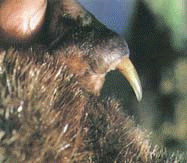 from
which a toxic fluid is ejected and which may be used as a weapon of
defense. The call of the platypus is a low growl.
from
which a toxic fluid is ejected and which may be used as a weapon of
defense. The call of the platypus is a low growl.
Duckbills are shy animals and
are seldom observed, even in localities where they abound. They are
active only during the early morning and late evening, and are
excellent swimmers and divers. They live in long, winding burrows,
which are usually  dug
by the females in the banks of rivers or streams. The burrows are
blocked with earth in several places as fortification against
intruders and flooding. At the end of the burrow, which may be from
about 30 to 59 feet in length, the female constructs a bed of weeds,
leaves, and grass, which it uses as a nest for the eggs and young,
and for a retreat. The male is excluded from the nesting burrow. The
female lays usually two but sometimes as many as four eggs in a
clutch. The young animals have no fur when they hatch. The female
uses its tail to clasp the young to its abdomen, enabling them to
nurse. Platypuses are unfortunately sometimes captured as biological
curiosities, but the hunting of platypuses is forbidden by law.
dug
by the females in the banks of rivers or streams. The burrows are
blocked with earth in several places as fortification against
intruders and flooding. At the end of the burrow, which may be from
about 30 to 59 feet in length, the female constructs a bed of weeds,
leaves, and grass, which it uses as a nest for the eggs and young,
and for a retreat. The male is excluded from the nesting burrow. The
female lays usually two but sometimes as many as four eggs in a
clutch. The young animals have no fur when they hatch. The female
uses its tail to clasp the young to its abdomen, enabling them to
nurse. Platypuses are unfortunately sometimes captured as biological
curiosities, but the hunting of platypuses is forbidden by law.
Scientific classification: The platypus makes up the family Ornithorhynchidae, in the order Monotremata. It is classified as Ornithorhynchus anatinus.
Microsoft ® Encarta ® Encyclopedia 2002. © 1993-2001 Microsoft Corporation. All rights reserved.